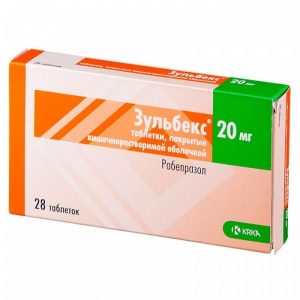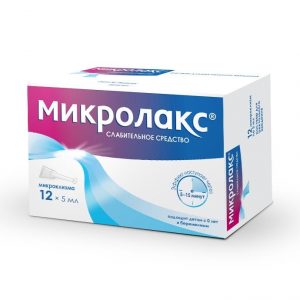Description
Release form for powder
Powder for preparation of oral suspension
Packing
5 pcs
Pharmacological action
Omeprazole is a weak base. It is concentrated in the acidic environment of the secretory tubules of the parietal cells of the gastric mucosa, it is activated and inhibits the proton pump, the enzyme H + / K + -ATPase.
The effect of omeprazole on the last stage of the formation of hydrochloric acid in the stomach is dose-dependent and provides highly effective inhibition of basal and stimulated secretion of hydrochloric acid, regardless of the stimulating factor.
Effect on gastric acid secretion
Omeprazole with daily oral administration provides fast and effective inhibition of daytime and nighttime hydrochloric acid secretion.
The maximum effect is achieved within 4 days of treatment. In patients with a duodenal ulcer, omeprazole at a dose of 20 mg causes a steady decrease in the acidity of the gastric juice by at least 80% for 24 hours. This achieves a decrease in the average maximum concentration of hydrochloric acid after stimulation with pentagastrin by 70% within 24 hours.
In patients with a duodenal ulcer, daily oral administration of 20 mg of omeprazole maintains the value of intragastric acidity at pH 3 for 17 hours.
Inhibition of hydrochloric acid secretion depends on the area under the pharmacokinetic curve concentration-time (AUC) of omeprazole, and not on the concentration of the drug in plasma at a given time.
Effect on Helicobacter pylori
Omeprazole in vitro has a bactericidal effect on Helicobacter pylori. Helicobacter pylori eradication with omeprazole in combination with antibacterial agents is accompanied by a rapid elimination of symptoms, a high degree of healing of defects in the gastrointestinal mucosa and a long-term remission of peptic ulcer, which reduces the likelihood of complications such as bleeding as well as continuous maintenance therapy.
Other effects associated with inhibition of hydrochloric acid secretion
In patients taking for a long period of time drugs that lower the secretion of the glands of the stomach, the formation of glandular cysts in the stomach of the cyst is more benign and pass independently on the background of continued therapy.
A decrease in the secretion of hydrochloric acid in the stomach leads to a slight increase in the risk of developing intestinal infections caused by Salmonella spp., Campylobacter spp. and Clostridium difficile.
During treatment with drugs that lower the secretion of the glands of the stomach, the concentration of gastrin in the blood serum rises. Due to a decrease in the secretion of hydrochloric acid, the concentration of chromogranin A increases (see the section “Special Instructions”).
Pharmacokinetics
Absorption
Absorption – high time to reach maximum concentration (Tcmax), on average – 30 minutes (10-90 minutes), bioavailability – 30-40% (with liver failure increases to almost 100%). Eating does not affect the bioavailability of omeprazole.
Distribution
The binding index of omeprazole to plasma proteins is about 95%, the distribution volume is 0.3 l / kg.
Metabolism
A portion of omeprazole undergoes a presystemic hepatic metabolism involving the isoenzymes CYP2C19 and CYP3A4 to form inactive metabolites of sulfone, sulfide and hydroxy-omeprazole. Omeprazole, not included by parietal cells in the formation of active metabolites, is completely metabolized in the liver also with the participation of CYP2C19 and CYP3A4 isoenzymes. The total plasma clearance is 0.3-0.6 l / min.
Excretion
The elimination half-life is about 40 minutes (30-90 minutes). About 80% is excreted as metabolites by the kidneys, and the rest is the intestines.
Special patient groups
No significant changes in the bioavailability of omeprazole in elderly patients or in patients with impaired renal function. In patients with impaired liver function, an increase in the bioavailability of omeprazole and a significant decrease in plasma clearance are noted.
Indications
Adults
heartburn and other symptoms gastroesophageal reflux disease (GERD)
non-erosive and erosive (reflux esophagitis) forms of GERD
peptic ulcer of the stomach and duodenum (including the prevention of relapse)
infection of patients with Helicobacter pylori combination therapy)
prevention and treatment of damage to the mucous membrane of the stomach and duodenum due to the use of non-steroidal anti-inflammatory drugs (NSAIDs gastrop ment): dyspepsia, mucosal erosion, peptic ulcer
hypersecretory conditions (Zollinger-Ellison syndrome, stress ulcers of the gastrointestinal tract, polyendocrine adenomatosis, systemic mastocytosis).
Children
Over the age of 2 years, with a body weight of more than 20 kg: in the treatment of gastroesophageal reflux disease
over the age of 4 years, with a body weight of more than 20 kg: in the treatment of duodenal ulcers caused by Helicobacter pylori.
Safety and effectiveness for other indications in pediatric patients not established.
Contraindications
Hypersensitivity to omeprazole, substituted benzimidazoles or other components of the drug, fructose intolerance, sucrose / isomaltase deficiency, glucose-galactose malabsorption (due to the presence of sucrose in the preparation).
The drug should not be used in conjunction with atazanavir, nelfinavir, erlotinib, posaconazole.
The use of omeprazole in children is contraindicated, except as indicated: gastroesophageal reflux disease for children over 2 years of age with a body weight of more than 20 kg and a duodenal ulcer caused by Helicobacter pylori for children over 4 years of age with a body weight of more than 20 kg (see section “Method of administration and dosage”).
Precautions:
Renal failure (dose adjustment of omeprazole not required).
Hepatic failure (see section “Dosage and administration”).
Osteoporosis. Although a causal relationship with the use of omeprazole with fractures associated with osteoporosis has not been established, patients with a risk of developing osteoporosis or fractures against its background should be under appropriate clinical supervision.
Use during pregnancy and lactation
Research results have shown that there is no adverse effect of omeprazole on the health of pregnant women, the fetus or the newborn.
Omeprazole is excreted in breast milk, but when used in therapeutic doses, exposure to the baby is unlikely.
Omeprazole is approved for use during pregnancy and during breastfeeding.
Composition of
Each packet contains:
active substance:
omeprazole 20 mg
excipients:
sodium bicarbonate 1680 mg,
xylitol 2000 mg,
sucrose 20 mg mg,
30 mg
Dosage and Administration
Inside. Pour the contents of the bag into a cup, add 1-2 tablespoons of water (do not use other liquids or food products!), Stir thoroughly until a homogeneous suspension is obtained and drink immediately. If necessary, you can drink a little water.
To ensure the following dosage regimens, it is possible to take the drug in another registered dosage (Omez ®, capsules, 10 mg, 20 mg and 40 mg Omez ® Insta, powder for oral suspension, 20 mg Omez ®, lyophilisate for solution for infusion, 40 mg).
Adults
– Heartburn and other symptoms associated with gastroesophageal reflux disease (GERD)
A single dose of 20 mg is sufficient to quickly relieve symptoms of heartburn.
– Non-erosive and erosive (reflux esophagitis) forms of GERD
Depending on the severity of esophagitis? from 20 mg to 80 mg per day. The daily dose can be divided into 2-3 doses.
The duration of the main course is 4 8 weeks. After healing of erosion, supportive treatment is indicated for 26 52 weeks, with severe esophagitis? for life. For the prevention of exacerbation of reflux esophagitis – 20 mg / day.
– Peptic ulcer of the stomach and duodenum (including the prevention of relapse)
20 mg once a day. To patients resistant to treatment with other antiulcer drugs? 40 mg / day. The course of treatment for peptic ulcer of the duodenum – 2 weeks, if necessary – up to 4 weeks, with peptic ulcer of the stomach – 4-8 weeks.
– Helicobacter pylori eradication in infected patients with peptic ulcer and duodenal ulcers, as well as other diseases requiring eradication (as part of combination therapy)
According to the recommendations of the Maastricht-4 Omez ® Insta work group, it can be included in the following treatment regimens: First line (standard triple regimen)
Omez ® Insta 20 mg 2 times a day + clarithromycin 500 mg 2 times a day + amoxicillin 1000 mg 2 times a day. To increase the effectiveness of therapy, it is possible to prescribe Omez ® Insta 40 mg (2 sachets of 20 mg) 2 times a day (doubling the standard dose) and increasing the duration of the course from 7 to 10-14 days.
Second line (four-component)
It is used if the standard triple therapy is ineffective or if the penicillin group is intolerant. Bismuth tripotassium dicitrate (120 mg 4 times a day) in combination with Omez ® Insta (20 mg 2 times a day), tetracycline (500 mg 4 times a day), metronidazole (500 mg 4 times a day) for 10 days .
The third line and other alternative treatment options are prescribed based on a study of the individual sensitivity of Helicobacter pylori to antibiotics.
– Prevention and treatment of damage to the mucous membrane of the stomach and duodenum, due to the use of non-steroidal anti-inflammatory drugs (NSAIDs-gastropathy), such as: dyspepsia, erosion of the mucous membrane, peptic ulcer.
For the purpose of prevention, Omez ® Insta is prescribed at a dose of 20 mg daily before breakfast during the entire course of treatment of NSAIDs with the aim of treatment – at a dose of 20 mg 2 times or once 40 mg (2 sachets of 20 mg) per day for 4-8 weeks .
– Hypersecretory conditions (Zollinger-Ellison syndrome, stressful ulcers of the gastrointestinal tract, polyendocrine adenomatosis, systemic mastocytosis) – 60 mg / day, if necessary, increase the dose to 80-120 mg / day (in this case, it is prescribed in 2-3 doses )
Children
Age over 2 years, with a body weight of more than 20 kg: for gastroesophageal reflux disease, it is recommended to prescribe the drug Omez ® Insta at a dose of 20 mg once a day. The duration of treatment is 4-8 weeks
over 4 years old, with a body weight of more than 20 kg: with a duodenal ulcer caused by Helicobacter pylori, at a dose of 20 mg once a day in combination with antibacterial drugs.
Use of the drug in special cases
Impaired renal function. Dose adjustment is not required.
Impaired liver function. In patients with impaired liver function, the bioavailability and clearance of omeprazole increase. In this regard, the therapeutic dose should not exceed 20 mg per day.
Old age. The metabolic rate of omeprazole in the elderly is reduced, but dose adjustment is not required.
Side effects of
From the hemopoietic organs: rarely – leukopenia, thrombocytopenia very rarely – agranulocytosis, pancytopenia.
From the digestive system: often – diarrhea or constipation, abdominal pain, nausea, vomiting, flatulence rarely – increased activity of liver enzymes, taste disturbance is very rare – dry mouth, stomatitis, gastrointestinal mucosa candidiasis in patients with previous severe liver disease – hepatitis (including with jaundice) is very rare – liver failure, including with the development of encephalopathy (in patients with a history of liver disease).
From the nervous system: often – headache infrequently – dizziness, paresthesia, drowsiness rarely – taste disturbance.
Mental disorders: infrequently – insomnia is rare – agitation, confusion, depression is very rare – aggression, hallucinations.
On the part of the sensory organs: infrequently – vertigo rarely – blurred vision.
From the musculoskeletal system: rarely – arthralgia, myalgia is very rare – muscle weakness.
From the skin: infrequently – dermatitis, pruritus, rash, urticaria, rarely – alopecia, very rare photosensitivity – erythema multiforme, Stevens-Johnson syndrome, toxic epidermal necrolysis.
Allergic reactions: rarely – hypersensitivity reactions, including fever, angioedema and anaphylactic reactions (including anaphylactic shock).
From the genitourinary and reproductive systems: rarely – interstitial nephritis very rarely – gynecomastia.
Metabolic disorders: rarely – hyponatremia very rarely – hypomagnesemia.
Other: infrequently – malaise, rarely peripheral edema – bronchospasm, increased sweating.
Drug Interaction
Owing to a decrease in the acidity of gastric juice, omeprazole treatment may reduce or increase the absorption of other drugs whose mechanism of absorption depends on the pH of gastric juice.
Reduces the absorption of ketoconazole and itraconazole.
Increases the absorption of digoxin. Co-administration of omeprazole at a dose of 20 mg once daily and digoxin increases the bioavailability of digoxin by about 10%.
Omeprazole has been shown to interact with some antiretroviral drugs. The mechanisms and clinical significance of these interactions are not always known. Increased pH in the stomach against omeprazole therapy may affect the absorption of antiretroviral drugs.
It is also possible to interact at the CYP2C19 level. When combined with omeprazole and antiretroviral drugs, such as atazanavir and nelfinavir, with serum omeprazole therapy, a decrease in serum concentrations is observed. Therefore, co-administration of omeprazole with antiretroviral agents such as atazanavir and nelfinavir is not recommended.
Increased serum concentrations of saquinavir were observed with omeprazole and saquinavir.
Omeprazole inhibits CYP2C19, the major isoenzyme involved in its metabolism.
Co-administration of omeprazole with other drugs involved in the metabolism of CYP2C19, such as diazepam, phenytoin, warfarin, other vitamin K antagonists and cilostazol, may reduce the metabolism of these drugs.
It is recommended that plasma phenytoin be monitored when phenytoin and omeprazole are administered concomitantly, in some cases, a reduction in phenytoin dose may be required. At the same time, in patients receiving long-term phenytoin, co-administration of omeprazole at a dose of 20 mg once a day did not cause a change in the concentration of phenytoin in the blood plasma.
When using omeprazole in patients receiving warfarin or other vitamin K antagonists, the control of INR may be required in some cases to reduce the dose of warfarin or other vitamin K antagonist. At the same time, co-administration of omeprazole 20 mg with patients receiving warfarin Once a day did not cause a change in coagulation time.
The use of omeprazole at a dose of 40 mg once daily resulted in an increase of Cmax and AUC of cilostazol by 18 and 26%, respectively, for one of the active metabolites of cilostazol, an increase of 29 and 69%, respectively.
Omeprazole does not affect the metabolism of drugs produced by CYP3A4, such as cyclosporine, lidocaine, quinidine, estradiol, erythromycin and budesonide.
Increased serum concentrations of tacrolimus were observed when omeprazole and tacrolimus were administered concomitantly.
CYP2C19 and CYP3A4 are involved in the metabolism of omeprazole. Co-administration of omeprazole and CYP2C19 and CYP3A4 inhibitors, such as clarithromycin and voriconazole, may lead to increased plasma concentrations of omeprazole by slowing the metabolism of omeprazole. Co-administration of voriconazole and omeprazole resulted in more than a twofold increase in omeprazole AUC, which however did not require dose adjustment of omeprazole.
drugs that induce CYP2C19 and CYP3A4, such as rifampicin and hyperthyroid drugs, when co-administered with omeprazole, may lead to a decrease in plasma concentrations of omeprazole by accelerating omeprazole metabolism.
Overdose
Symptoms: headache, dizziness, drowsiness, confusion, tachycardia, arrhythmia, blurred vision, drowsiness, dry mouth, nausea, vomiting, flatulence.
Treatment: symptomatic. If necessary – gastric lavage, activated charcoal. Hemodialysis is not effective enough.
Storage conditions
At a temperature not exceeding 25 ° C.
Keep out of the reach of children!
Expiration
2 years.
Deystvuyuschee
substance omeprazole
Pharmacy terms
Prescription
Dosage
dosage form
oral suspension




